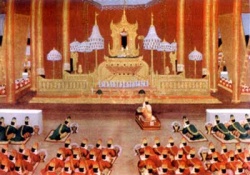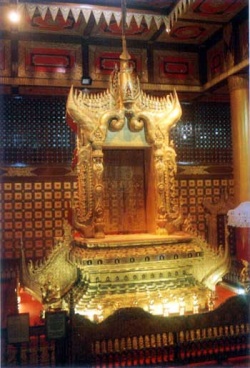The thrones of Myanmar kings
By definition a throne is a noble seat; and according to Myanmar chronicles, there are three types of thrones: the seat of the Buddha, the seat of the King of Celestials and the seat of human monarchs. The three has a connection, as the King of Celestial's most important virtue is being protector of Buddhism, and the kings' thrones have a figure of the Celestial King carved on its apex to symbolize that the human king too, is upholder of the faith.
Tragically, under the bombs of World War II the last palace in Mandalay was destroyed. A replica has been built on the site but only one throne out of the original nine survived.
As two are identical, the Lion Thrones, it is normal to refer to them as the Eight Thrones. The number eight is in accordance with the Eight Virtues of a king, which has more to do with the administrative aspects and less with the honours of the Ten Duties of a king. Such lists predominate traditional ethical discourses.
The nine requisite thrones which once graced Mandalay palace were carved simultaneously on Friday, the 11 th Waning Moon Month of Kason, BE 1220, which would be sometime in May of 1858. Mandalay officially became the capital in 1859.
Different woods and with different motifs were used, such as animal, flower or bird motifs. The thrones were placed in various pavilions according to the type of ceremony to be performed in the Royal presence.
The sole surviving throne is one Thiha Thana Lion throne, at present in the National Museum of Yangon. It is completely gilded with pure gold, and richly decorated with intricate carvings. As its name implies, the Thiha Thana throne is based on the lion motif, as lion in the old Pali language is Thiha.
The lion, symbol of courage and power, is an auspicious animal in Myanmar legends. The Lion Throne is the most important throne, and in the palace it was placed in the Great Audience Hall also known as the Myey Nan Pyat-that. Myey Nan means the Earth Pavilion, for the throne rests on a platform of rare and auspicious earth mixed and packed tight. This throne was directly under the seven-towered roof of high spires, which marked the center of the power of the realm. In fact, according to Myanmar chronicles, the very spot under the seventiered roof was the center of the Earth.
According to a rare palm leaf manuscript written by a Royal architect named Shwe Taung Nawrahta in 1816, there were not only rigid rules and specifications for each throne but elaborate ceremonies to be performed even during the carving process. All In nine thrones must be carved simultaneously in a specially built and decorated workshop. The wood has to be cut from unblemished trees, one type of wood for each type of throne, and the tree must be growing on 'untainted' ground such as places far from cemeteries.
The carvers were given sets of tools of gold and silver; presumably only the handles are of these precious metals. Exactly at the auspicious time chosen by court astrologers, the first strokes of cutting began accompanied by music and dancing and with all ritual food, flowers, incense and homage offerings set out in order. Supervised by nobles dressed in ceremonial robes, the work must begin in an instant of calculated time. When it was lunchtime, the workers must all put down their tools at once. Food was brought in with ceremony and the first portion presented to the King as a gesture of homage before the rest was given as out to all those present, beginning with the highest ranking noble down to the youngest carpenter.
The lion Throne, 34 ft 6" high, was made of Yamanay wood (Gmelina Arborea ), a rare light wood also used to carve marionettes. The base is in the form of two lotus blossoms, one upright, and the bottom one inverted. Inside three horizontal bands there are small niches with lion figurines.
The top of the throne widens and flares up at the sides. In the very center of the lintel is a spire with a figure of the Celestial King. He represents protection of the Buddhist faith, and fairness in judging the people. Just above his image, there are the Nine Noble Gems: Ruby for Glory, Diamond for Honour, Pearl for Grace, Coral for greatness, Zircon for Strength, Sapphire for Adoration, Cat's Eye for Power, Topaz for Health and Emerald for Peace.
On the lintel itself there are figures of celestial beings, eight on each side, standing on lotus blossoms.
On either side of the throne on the doorjambs are four figures of Sama Deva Good Celestials. They represent the fact that the king sits in the center of the four corners of the earth. In the middle of the jamb are, on the right, a rabbit, and a peacock on the left. They are the symbols for the moon and the sun and signify eternal brilliance.
At the bottom of each jamb are carvings of a lion and an elephant fighting. The legend goes that as these two powerful animals fought, causing great damage to the earth, a Deva (Celestial Being) called the Lawka Nat appeared to sing and dance. His music soothed the anger of the beasts. The Lawka Nat figures are placed in the center of each door panel. This legend is set into the throne to symbolize the power of the king as arbiter of disputes and one who brings peace to the land.
On each side of the throne there is a figure of a Kainaree and a Kainara, the birdhuman people. They symbolize faithfulness, as well as joy in the propagation of Buddhism. In a row in front of the throne there are eight figures of male children, hands raised in prayer. They symbolize growth, and as a child grows so would the King's glory increase.
Other gold regalia items totaling 35, such as caskets, slippers, fly whisks, betel boxes and various implements including a chin rest, were displayed on either side of the throne during three important ceremonies a year. These golden objects are also on display at the National museum in a separate room.
When the unpolished basic form of the thrones was completed, they were set up with ceremony and offerings in the different pavilions. Then only was it time for the gilders to start the decorating process, which they do by using sap of a gum tree to adhere sheets of , thin gold top the wood. Fake diamonds and rubies are set into the figures and the floral scrollwork.
Only the King and the Chief Queen were allowed to sit on the Thiha Thana throne. They could climb up to the throne by a short flight of seven steps behind the throne and through a door at the back. The stairs were screened off with walls on either side of the throne so that the audience in the chamber could not see the Majesties before they were seated. There was also a custom for the King to present a throne to a prince of a feudal state, and one was said to be presented to the Sawbwa of Kyaing Ton of the Shan State. Such a throne was not for the prince to sit on, but to place his hand on it as he ruled in court cases so as to a symbolize justice.
Only the most important ceremonies were performed in the Great Audience Hall with the King and Queen seated on the Lion Throne. The three annual ceremonies of paying homage by subjects to their Majesties were always held in this throne room.
On New Year's Day, which falls sometime in April according to the Myanmar lunar calendar members of the Royal Family and nobles came to offer obeisance and gifts. Similar ceremonies were held in the palace for the beginning of Lent and to celebrate its end after three months. For this last ceremony, sometime in October, governors of provinces and rulers of tributary States would come to pay homage. The Heir to the throne, ministers, officials of the military etc. had to be present as it was more a political than a religious occasion. The oath of loyalty was renewed at this ceremony.
The only woman to be present here was the Chief Queen. The other queens however could look on from the screened-off room behind the throne. Foreign dignitaries were also given audience in this chamber.
Another Lion Throne, identical to this, was kept in the Hall of Victory chamber of the Hluttaw Parliament building, where the king conferred with his ministers twice a day, and issued formal orders or judged important cases.
The other seven thrones were kept in various pavilions used for special purposes.
The Bhamara Thana Throne (the Bee Throne) was made from Karaway wood (of the Cinnamomum spp. family) and kept in the Glass Palace. The bee is believed to be a wise creature and thus the use of it as a motif symbolized the King's wisdom. This throne was not so ornately decorated. Here, the ceremonies to honour favourite daughters take place as well as their ears-piercing rituals. At those occasions Their Majesties would bestow on the princesses gifts of servants, elephants, cattle, golden barges, orchards etc.
The Padumma Thana Throne, with the lotus motif was carved from the wood of mango (Mangifera indica), and kept in the Ladies' Audience Hall. It was made in exactly the same style as the Lion Throne with only the difference in motif. The deer motif Miga Thana Throne was in the South samoke chamber to the far right of the Glass Palace, and made from a kind of fig, the Yay th'phan Thar wood. (Ficus gloremata).
The deer motif symbolized prosperity for the nation. From this throne the King would inspect gifts to be made to the religious Order, and in this chamber novitiation ceremonies of his sons took place.
The Marura Thana Throne made of Padauk wood (Pterocarpus macrocarpus) and bearing peacock motifs was kept in the North samoke pavilion. Here he received feudal lords of other nationalities who came with gifts of elephants and horses. In the Jataka tales, the Buddha-to- be as a golden peacock had overcome all dangers by his love.
The Hintha bird based Hantha Thana Throne was made from a kind of hardwood Thingan sometimes called the Rock Dhamma.
This was kept in the Zaytawun pavilion set behind the Glass Palace. This was also where foreign dignitaries had their audience. The Hintha bird is a symbol of authority, dignity, purity and gentleness.
In the pavilion where the King and Queen liked to take their leisure the Thinga Thana Throne based with conch shell motifs was
placed. The wood used for this was a kind of jackfruit wood (Artocarpus heterophyllus).The conch shell, one of the symbols of Buddha, was believed to bring greater wealth and prosperity to the country. The king received monks and listened to their sermons in this pavilion, apart from taking afternoon tea.
The last, the Garza Thana Throne was made from White Champac wood (Michelia Champaca), and was carved with elephant motifs. The elephant symbolized longevity and sovereignty. It was kept in the Byay Taik, the Privy Council room. Here the King would preside when appointing officials to his Royal service.
The modern weapons of war destroyed, and will continue to destroy, not only lives but priceless cultural assets. In spite of this
senselessness the people will still cherish good memories and their heritages in their hearts.

